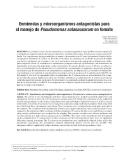Enmiendas y microorganismos antagonistas para el manejo de Pseudomonas solanacearum en tomate
Alternative title
Amendments and antagonistic microorganisms in Pseudomonas solanacearum management in tomato
Description
3 ilus. 22 ref.
Abstract
Se estudió el efecto de dos enmiendas y tres microorganismos como posibles factores supresores y antagonistas, respectivamente, del agente causal de la marchitez bacteriana, Pseudomonas solanacearum E.F. Smith. Los experimentos fueron conducidos en campo e invernadero en el Centro Agronómico Tropical de Investigación y Enseñanza (CATIE), en Turrialba, Costa Rica. Se establecieron en diseño de parcelas divididas con cuatro repeticiones en el campo y tres en el invernadero. Las parcelas principales se dispusieron en bloques completos al azar. Se evaluaron tres tratamientos (compost comercial, cal dolomítica y un tratamiento sin enmiendas) en las parcelas principales y ocho tratamientos (P. cepacia, Bacillus cereus y Glomus occultum solos y en combinación) en las subparcelas. Los tratamientos con enmiendas se asignaron a las parcelas principales, mientras que los tratamientos con antagonistas se asignaron a las subparcelas. Las variables evaluadas fueron incidencia y severidad de la enfermedad y área bajo la curva de progreso de la enfermedad (ABCPE). Se determinó el efecto de las enmiendas sobre las poblaciones de P. solanacearum en tres momentos. En el campo no hubo diferencias significativas entre las variables evaluadas. Las poblaciones de P. solanacearum fueron reducidas significativamente en el suelo. En invernadero, las enmiendas redujeron significativamente la severidad de la enfermedad y el ABCPE. Los antagonistas no redujeron significativamente la incidencia y la severidad en el campo e invernadero. The effects of two amendments and three microorganisms were studied as possible suppressive and antagonistic factors of bacterial wilt Pseudomonas solanacearum E.F. Smith. The experiments were conducted in field and greenhouse at the Tropical Agriculture Research and Higher Education Centre (CATIE), located in Turrialba, Costa Rica. Treatments were arranged in a split-plot, using randomized complete block array with four (field) and three (greenhouse) repetitions. Three treatments were evaluated in the main plots and eight in the subplots. The treatments with amendments (commercial compost and dolomit lime) and control plot were assigned to the main plots, while treatments with the antagonists (P. cepacia, Bacillus cereus and Glomus occultum alone and in combinations) were assigned to the subplots. The response variables were disease incidence and severity and the area under disease progress curve (AUDPC). The effect of the amendments was determined on the populations of P. solanacearum in three moments. In the field experiment there were no significant differences among treatments. The P. solanacearum populations were significantly reduced in the soil. In the greenhouse experiment, the amendments reduced significantly disease severity and the AUDPC. The antagonists did not significantly reduce incidence and severity in both field and greenhouse trials.
Keywords
Publisher
Centro Agronómico Tropical de Investigación y Enseñanza (CATIE), Turrialba (Costa Rica)
URI (Permanet link to cite or share this item)
https://repositorio.catie.ac.cr/handle/11554/6205Collections
- Publicaciones y documentos [4419]


